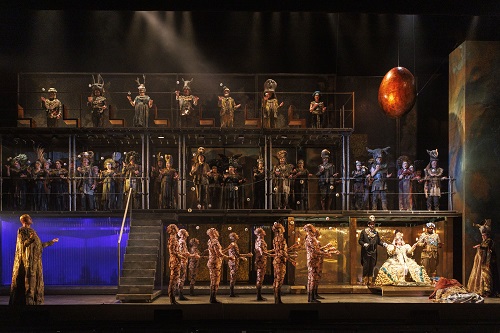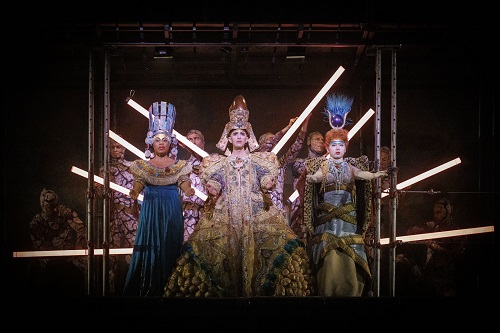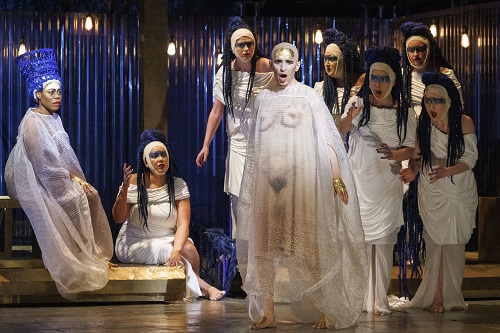Those lavish costumes, the fiery sun and the troupe of jugglers continue to leave a vivid impression in Phelim McDermott’s sumptuous staging of Akhnaten. Now in its second revival since English National Opera and Improbable theatre company’s first unveiling in 2016, the work has lost none of its exotic allure, nor its capacity to confound. With the deliberate absence of surtitles, the slow-motion unfolding of Philip Glass’s 1983 ‘portrait’ opera, beginning with those obsessive arpeggios, can still make for a perplexing evening. Regardless of the visual spectacle so brilliantly devised by Tom Pye, Kevin Pollard and Bruno Poet, Akhnaten continues to divide those who revere or revile its emotionally detached, yet fascinating slice of Egyptology belonging to 14th-century BC.
Unfolding via a series of tableaux, the three acts outline the rise and fall of the sun-worshipping and androgynous Pharaoh. Within his brief reign Akhnaten discards the ancient gods, moves his capital city and promotes an ideology of a single deity, the Aten – a pioneering and extreme vision developed two centuries later by Moses. It’s a step too far for the old guard and following his assignation by a reactionary populace, polytheism returns and a new boy King, Tutankhamun, is crowned. Elusive spoken texts in English and sung words in Egyptian, Hebrew and Akkadian, variously assembled from ancient hymns, prayers and inscriptions, do for the libretto, while meaning accrues from its thin plot and mimed action.

Filling the back of the stage beneath tiered surfaces are three glass panels resembling museum exhibits, and artfully suggest the inside of a pharaoh’s tomb. Within the central chamber Amenhotep III is embalmed, while actors above in silhouette perform animated hieroglyphs. These illustrative scenes obviate the need for surtitles and underline the production’s ‘show not tell’ concept, explicitly conveyed with the crowning of Akhnaten. The transformation from his naked first entry to a splendidly bejewelled monarch is as mesmerising as the supporting propulsive rhythms which create a striking contrast to the stately pace on stage. It’s a juxtaposition heightened by the ten members of the Gandini Juggling Company, whose talents in keeping aloft an array of balls, clubs and orbs mirrors the mechanistic quality of Glass’s music. Inevitably, our attention is drawn to the possibility of dropped balls or even the relevance of the jugglers, their unlikely presence justified, according to the programme book, by images on an Ancient Egyptian wall painting.

The intermittent ball tossing also underlines a work suffused with ritual, outlined early on by the gradual dismemberment of Amenhotep III and later the sinuous duet between Akhnaten and Nefertiti whose blood-red robes snake across the stage and threaten to tie them in knots. A sense of looking through history is achieved from Kevin Pollard’s costumes in their ancient to modern traversal. Especially effective is the placing of Akhnaten in a white frame, its chiaroscuro effect suggesting a Renaissance oil painting. His measured ascent up a ladder to praise the sun god, a blazing ball of light, remains the dramatic apex of Act 2.

On opening night, the American counter-tenor Anthony Roth Costanzo sang the title role with sustained power, and if the metallic edge to his voice lacked warmth his ‘Hymn to the Sun’ possessed a noble intensity. He was well supported by the rich mezzo of Chrystal E Williams’s Nefertiti, while South Korean soprano Haegee Lee as Queen Tye, Akhnaten’s mother, sounded just a little strident, but managed to blend well in ensemble passages. Zachary James imposed as the pontificating Scribe and Narrator, and the trio of dissenters – Paul Curievic’s High Priest of Amon, Jolyon Loy’s Aye (his top hat adorned with a skull) and Benson Wilson’s general Horemhab – all delivered their roles with authority. No less convincing in their passages of choral recitation were the six daughters of Akhnaten, nor the ENO chorus whose singing brought powerful expression to the outer acts.
In the pit, Karen Kamensek guided the orchestra with cool assurance, the players unfazed by the score’s repetitions and subtle changes of metre. Judging by this performance, there’s no doubt Akhnaten continues to pack a punch; its rituals and striking juxtapositions still grip the imagination.
David Truslove
Akhnaten – Anthony Roth Costanzo, Nefertiti – Chrystal E. Williams, Queen Tye – Haegee Lee, General Horemhab – Benson Wilson, Aye – Jolyon Loy, High Priest – Paul Curievici, Scribe – Zachary James, Daughters of Akhnaten – Ellie Neate, Isabelle Peters, Ella Taylor, Felicity Buckland, Amy Holyland & Lauren Young, Director – Phelim McDermott, Set & Projection Designer – Tom Pye, Costumes – Tom Pollard, Lighting – Bruno Poet, Choreographer – Sean Gandini, Conductor – Karen Kamensek, Chorus and Orchestra of English National Opera.
English National Opera, London Coliseum; Saturday 11th March 2023.